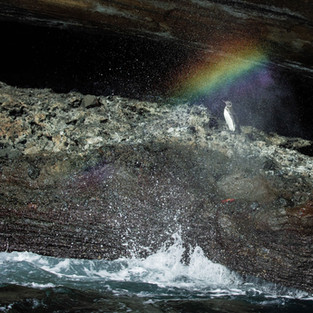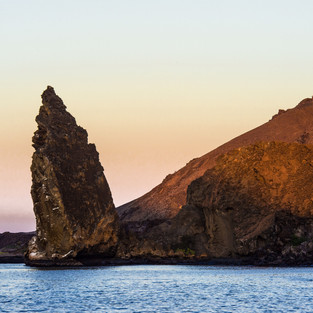Galápagos Penguin, Spheniscus mendiculus
Coolest Fact: This is the only penguin species found in the Northern Hemisphere. It is the world’s only tropical penguin. At the iconic location of Bartolomé Island, with the huge stone pointed column, if you’re lucky, you can find a small colony of penguins. They are exactly .5 miles north of the Equator!
Where It’s Found: Galápagos Islands. The biggest numbers—about 95%—are found on the western islands of Isabela and Fernandina. Most itineraries in the Galápagos do not visit the westernmost islands. It is one of the endemic species of the Galápagos Islands.
Crucial Facts:
· IUCN Red List Status: Endangered
· Population: fewer than 2000 individuals; declining (perhaps 6,000 – 15,000 in 1972); the Galápagos penguin is likely the rarest species of penguin
· Mating: monogamous; can breed any time of the year, depending on food availability up to three times per year
· Nesting: rough nests of stones, feathers, bones in the lava tubes, caves, crevices; extremely thick shells on the eggs
· Life at Sea: coast-hugging species, shallow divers
· Preferred Food: small fish like sardines and mullet
· Life span: about 10 years; a few can make it to 15 – 20 years
· Threats: El Niño (warm waters), climate change, and introduced predators
First Sighting: January 24, 2003
Our Story:
The Galápagos penguin was the very first species of penguin we saw. It’s crazy, really, since penguins are supposed to be found in Antarctica. But we were on the Equator in the Galápagos Islands. It was hot and sunny and not-at-all what you think when you think penguins. The Equator seems to the most unlikely place in the world to see a penguin.
We were snorkeling off the sandy beach at Bartolomé Island. It’s an iconic location in the Galápagos Islands, with the massive stone column like a pointed spike. I was on a mission to find penguins. I flopped into the water along the rocky edges of the bay, and – before taking even two swim strokes – realized that two penguins were standing on the dark lava rocks right beside me. No more than three feet away!
I stopped immediately. The water was shallow. I could stand on the bottom in chest-deep water. Holding on to a rock to stay in place, I was amazed that the penguins did not jump immediately back into the sea and swim away. Instead, they ignored me, completely unfazed by my presence.
I’m not sure how long they gave me the honor of their company. After perhaps half an hour, they took a couple steps and walloped into the water. I followed as they swam across the small bay toward the stone spire. The pace was leisurely. They swam under water while I paddled on the surface, watching through my face mask. As we neared a group of snorkelers, the penguins suddenly shot out of sight, leaving a trail of bubbles behind.
I’d hoped to see penguins on this trip, but this was so much more than I had expected. At that time, I had no idea that it was the beginning of a seventeen-year quest to see every one of the world’s species of penguins in the world. Over and over again, we’ve encountered this same friendliness in penguins. Not all species allow such close encounters, to be sure. But many do. It is part of what makes penguins so endearing. It’s a glimpse of what our relationships with animals might be, if we did not persecute them.
This new penguin series includes stories, information, and photos not yet published. Read about our quest to see all 18 of the world’s penguin species in my book “Every Penguin in the World.”






Comments